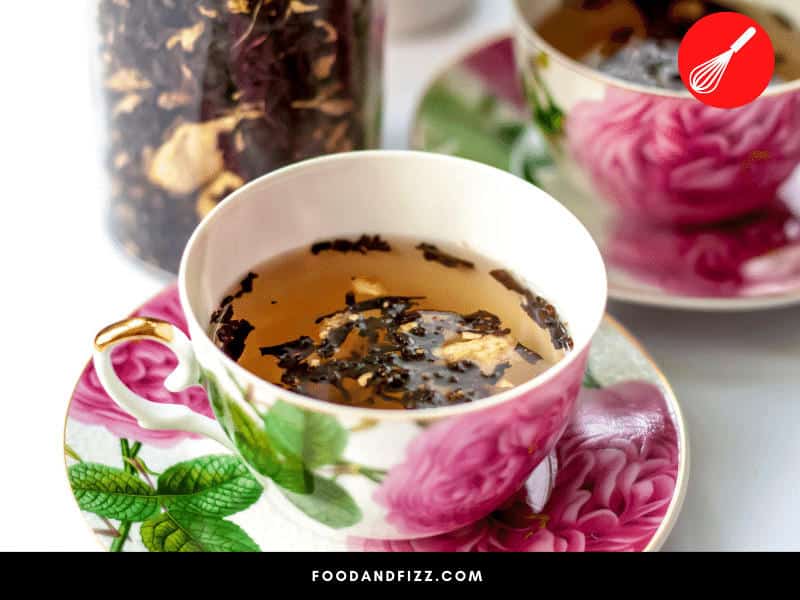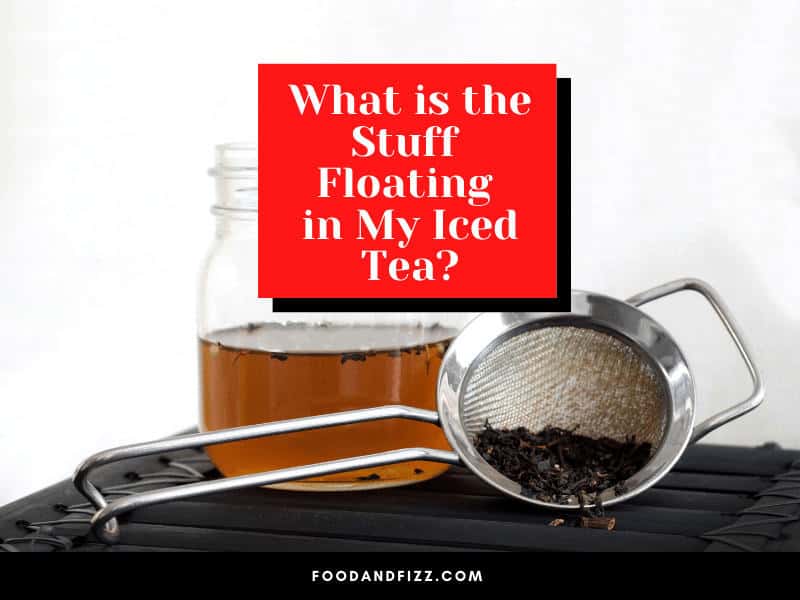Have you ever poured yourself a refreshing glass of iced tea, only to notice something unusual floating on the surface? It's a common occurrence that leaves many tea enthusiasts puzzled. The sight of tiny particles or debris swirling around in your drink can be unsettling, but it's essential to understand the reasons behind it. This phenomenon is often attributed to natural tea components, improper brewing techniques, or even contamination. In this article, we’ll explore the science behind the "stuff floating in iced tea" and provide practical solutions to ensure your beverage remains clean, safe, and delicious.
From the moment you open a tea bag or brew loose leaves, various factors can influence the clarity of your final drink. While some floating particles are harmless and even beneficial, others might indicate poor-quality ingredients or inadequate storage. Understanding the differences is crucial for maintaining a healthy and enjoyable tea-drinking experience. By the end of this article, you'll have a comprehensive understanding of what causes these particles and how to address them effectively.
This guide dives deep into the world of iced tea, examining both the science and practical aspects of brewing. Whether you're a casual tea drinker or a connoisseur, the information provided here will help you make informed decisions about your favorite beverage. Let’s explore the reasons behind the "stuff floating in iced tea" and discover ways to enhance the quality of your drinks.
Read also:Discover The Mall Of Americas Prime Location Explore Minnesotas Shopping Haven
What Exactly is the Stuff Floating in Iced Tea?
When you notice small particles floating in your iced tea, it’s natural to wonder what they are and whether they pose any health risks. These particles can come from various sources, including natural tea components, additives, or contaminants. For instance, tea leaves naturally contain tannins, caffeine, and other compounds that may dissolve or remain suspended in the water during brewing. These tiny fragments are typically harmless and contribute to the flavor profile of your tea.
However, other factors, such as dust from poorly processed tea leaves or residue from teabags, can also contribute to the floating debris. Additionally, if your tea is brewed using tap water with high mineral content, you might notice sediment settling at the bottom of your glass. Understanding the origin of these particles is the first step in addressing the issue and ensuring your iced tea remains clear and appealing.
Could the Stuff Floating in Iced Tea Be Harmful?
One of the most common concerns among tea drinkers is whether the "stuff floating in iced tea" poses any health risks. In most cases, the particles are harmless and are simply byproducts of the brewing process. However, if you notice unusual colors, odors, or textures in your tea, it could indicate contamination or spoilage. For example, mold or bacteria growth can occur if tea is stored improperly or left at room temperature for extended periods.
To ensure safety, always use fresh, high-quality tea leaves or bags and store them in a cool, dry place. Avoid using tap water with high mineral content, as it can introduce unwanted particles. If you’re unsure about the source of the floating debris, consider filtering your tea before serving. This simple step can help remove any unwanted particles and improve the clarity of your drink.
Why Does Stuff Floating in Iced Tea Happen More in Some Brands?
Not all tea brands are created equal, and the quality of the ingredients can significantly impact the clarity of your iced tea. Some brands use lower-quality tea leaves that are more prone to shedding particles during brewing. Others may include additives or preservatives that contribute to the floating debris. Additionally, the manufacturing process can influence the final product, with poorly processed tea leaves often resulting in more sediment.
When choosing a tea brand, look for options that emphasize quality and transparency in their sourcing and production methods. Reading customer reviews and checking for certifications, such as organic or fair trade, can also help you make an informed decision. By selecting a reputable brand, you can minimize the chances of encountering unwanted particles in your tea.
Read also:Unveiling The Remarkable Achievements Of Dr Faye Bate A Beacon Of Inspiration
How Can You Prevent Stuff Floating in Iced Tea?
Preventing unwanted particles in your iced tea starts with proper brewing techniques and ingredient selection. First, ensure you’re using high-quality tea leaves or bags that are free from dust and debris. Next, consider using filtered water to eliminate any impurities that might contribute to the floating debris. Additionally, brewing your tea at the correct temperature and for the right amount of time can help reduce the release of tannins and other compounds that may cloud your drink.
- Use fresh, high-quality tea leaves or bags
- Opt for filtered water to remove impurities
- Brew at the recommended temperature and time
- Store tea in a cool, dry place to maintain freshness
Is Filtering Iced Tea Necessary to Remove Floating Debris?
While filtering your iced tea isn’t always necessary, it can be a helpful step in improving the clarity of your drink. A fine mesh strainer or coffee filter can effectively remove small particles and sediment, leaving you with a smoother, more visually appealing beverage. However, over-filtering can also strip your tea of its natural flavors and nutrients, so it’s important to find a balance that works for your taste preferences.
Alternatively, you can try brewing your tea using a French press or similar method, which allows the tea leaves to steep without introducing excess debris. This technique can help preserve the flavor while minimizing the presence of floating particles.
What Are the Best Practices for Brewing Iced Tea Without Floating Stuff?
Adopting best practices for brewing iced tea can significantly reduce the chances of encountering unwanted particles. Start by measuring the right amount of tea for your desired strength, as using too much can lead to excessive sediment. Next, ensure your brewing equipment is clean and free from residue that might contaminate your tea. Finally, store your brewed tea in an airtight container in the refrigerator to prevent spoilage and maintain its quality.
By following these simple steps, you can enjoy a refreshing glass of iced tea without worrying about the "stuff floating in iced tea."
Can the Stuff Floating in Iced Tea Enhance the Flavor?
Believe it or not, some of the particles floating in your iced tea can actually enhance its flavor. Tannins, for example, are natural compounds found in tea leaves that contribute to the beverage’s astringency and complexity. While excessive tannins can make your tea taste bitter, the right balance can create a rich, full-bodied flavor profile. Similarly, small fragments of tea leaves can release additional flavors and aromas during brewing, adding depth to your drink.
However, it’s important to strike a balance between flavor enhancement and clarity. If the floating debris becomes too overwhelming, it can detract from the overall drinking experience. Experimenting with different brewing techniques and tea varieties can help you find the perfect combination of flavor and appearance.
What Should You Do if the Floating Stuff Smells or Tastes Bad?
If the "stuff floating in iced tea" has an unpleasant smell or taste, it could indicate contamination or spoilage. In such cases, it’s best to discard the tea and start fresh. Pay attention to the expiration date on your tea packaging and avoid using tea that has been stored for too long. Additionally, ensure your brewing equipment is clean and free from residual odors or flavors that might affect your tea.
When in doubt, trust your senses. If something doesn’t smell or taste right, it’s better to err on the side of caution and avoid consuming it. By practicing good hygiene and storage habits, you can minimize the risk of encountering spoiled or contaminated tea.
How Can You Test the Quality of Your Tea Before Brewing?
Before brewing your iced tea, it’s a good idea to inspect the quality of your tea leaves or bags. Look for signs of dust, debris, or discoloration that might indicate poor processing or storage. You can also perform a quick smell test to check for any off-putting odors that might suggest spoilage. If you’re using loose leaves, consider sifting them through a fine mesh sieve to remove any unwanted particles before brewing.
By taking these precautions, you can ensure that your tea is of the highest quality and free from any contaminants that might affect its taste or appearance.
Final Thoughts on Stuff Floating in Iced Tea
The phenomenon of "stuff floating in iced tea" is a common occurrence that can be attributed to various factors, including natural tea components, brewing techniques, and ingredient quality. While some particles are harmless and even beneficial, others might indicate contamination or poor-quality ingredients. By understanding the science behind this issue and adopting best practices for brewing, you can enjoy a delicious and visually appealing glass of iced tea every time.
Remember to prioritize quality when selecting tea brands and always follow proper storage and brewing techniques. With a little care and attention, you can minimize the presence of floating debris and enhance the overall experience of your favorite beverage.
Table of Contents
- What Exactly is the Stuff Floating in Iced Tea?
- Could the Stuff Floating in Iced Tea Be Harmful?
- Why Does Stuff Floating in Iced Tea Happen More in Some Brands?
- How Can You Prevent Stuff Floating in Iced Tea?
- Is Filtering Iced Tea Necessary to Remove Floating Debris?
- What Are the Best Practices for Brewing Iced Tea Without Floating Stuff?
- Can the Stuff Floating in Iced Tea Enhance the Flavor?
- What Should You Do if the Floating Stuff Smells or Tastes Bad?
- How Can You Test the Quality of Your Tea Before Brewing?
- Final Thoughts on Stuff Floating in Iced Tea


